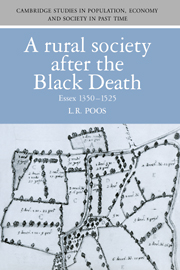Book contents
- Frontmatter
- Contents
- List of figures
- List of tables
- Preface
- Abbreviations
- Part I Reflections on a transitional era
- Part II ‘Country-dwellers, common folk and craftsmen’
- Part III ‘The total sum of all persons’
- Part IV ‘While it is so forward between us’
- Part V ‘She came that day seeking service’
- Part VI ‘Beware of such holy men’
- Part VII Synthesis
- Bibliography
- Index
- Cambridge Studies in Population, Economy and Society in Past Time 18
Part IV - ‘While it is so forward between us’
Published online by Cambridge University Press: 14 September 2009
- Frontmatter
- Contents
- List of figures
- List of tables
- Preface
- Abbreviations
- Part I Reflections on a transitional era
- Part II ‘Country-dwellers, common folk and craftsmen’
- Part III ‘The total sum of all persons’
- Part IV ‘While it is so forward between us’
- Part V ‘She came that day seeking service’
- Part VI ‘Beware of such holy men’
- Part VII Synthesis
- Bibliography
- Index
- Cambridge Studies in Population, Economy and Society in Past Time 18
Summary
Migration, settlement, marriage and household formation were processes central to the social structure of the district's population during the later middle ages. Propensity to move or marry, and the ages at which people did so, were personal demographic experiences that differed among different social or occupational groups in the Essex countryside. And the objective measures of these demographic experiences that are available from the district constitute the least ambiguous indices by which late-medieval Essex countryfolk mirrored the lives of their early-modern counterparts.
Marriage was a process with many legal and qualitative or experiential implications. Most importantly from the demographic perspective, it represented the inception of a new household, and thus the accumulation of the material means that made neolocal marriage possible. But in a rural society marked by persistent disparity between richer and poorer at village level, nuptiality varied between occupational subgroups. And so for agriculturalists, marriage was an experience likely to occur earlier in life, or more likely to occur at all, than was the case for craftsmen and retailers, and the differences between agriculturalists and labourers in these respects were even more marked. In short, for all people in the district nuptiality was linked with living standards, while still generally falling, as closely as the available evidence allows one to observe, within the realm of what historical demographers term the ‘Northwestern European marriage pattern’.
Only a minority of people in the Essex countryside at the end of the middle ages spent their entire lives residing in a single parish.
- Type
- Chapter
- Information
- A Rural Society after the Black DeathEssex 1350–1525, pp. 131 - 132Publisher: Cambridge University PressPrint publication year: 1991
- 1
- Cited by

